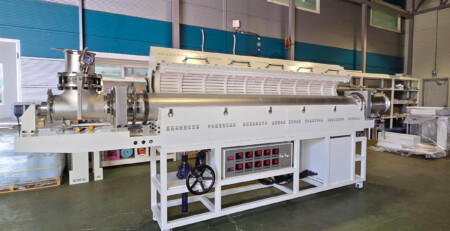8 Exciting Applications Of Biomass Pyrolysis In The Real World
SH Scientific equipment helps researchers harness the sustainable-energy potential of biomass.
Built from the ground up for continuous processing, our rotary tube furnaces offer world-class performance in an intuitive and cost-effective package.
Below, we’ll briefly highlight eight of the most exciting applications of biomass pyrolysis—many of which our customers are actively researching.
Biochar & heat/steam production
Biochar is the solid substance that biomass yields during pyrolysis.
Its exact chemical characteristics depend on those of the feedstock, but biochar is generally porous with ample surface area and high carbon content. Its composition, structure, and energy density are each useful in their own right, so biochar appears in a wide range of applications:
- Soil amendment
- Carbon sequestration
- Water filtration
- Waste management
- Energy production
Production of energy, namely heat and steam, is a particularly interesting and practical use. For instance, the intense heat released during pyrolysis can itself help dry out other feedstocks for future processing, thereby boosting the energy efficiency of the entire process.
Biocoal & solid fuel production
Biocoal is a solid, energy-dense fuel derived from the torrefaction of biomass.
Torrefaction involves long residence times and relatively low temperatures, causing the feedstock to shed excess moisture and volatile compounds. The result is a stable, carbon-rich product with approximately 30% higher energy content compared to the raw biomass.
Biocoal resembles charcoal and is often used in similar ways, including:
- Co-firing with coal in conventional power plants.
- As a standalone fuel source in, e.g., industrial boilers and heating systems.
- As an easily transported energy source in pellet or briquette form.
Depending on the power source used for torrefaction, biocoal can be a low-impact way to turn varied organic waste into a manageable and cleaner-burning energy source.
Liquid smoke production
Liquid smoke is a widely used byproduct of the pyrolysis of wood biomass. It’s a popular flavoring, coloring, and even preservative agent in everything from meats and cheeses to specialty condiments.
At higher temperatures, pyrolysis yields volatile compounds in addition to the usual solids, oils, and gases. These volatiles can be condensed into a liquid, yielding liquid smoke. Naturally, its aroma and flavor reflect the content (especially the phenol content) of the feedstock.
Liquid smoke is more typically prepared by smoldering, but researchers believe pyrolysis offers a cleaner and more efficient alternative.
Wood vinegar production
Wood vinegar (pyroligneous acid) is condensed from vaporous byproducts of pyrolysis. A natural pesticide and fungicide, it’s widely used in agriculture and gardening.
Wood vinegar is not toxic to people or large animals, and actively promotes beneficial microbial activity in soil. It even appears to be an effective bovine anti-parasitic agent, among numerous other emerging uses.
Traditional production techniques with rudimentary kilns have been well known for some time. However, a rotary tube furnace makes it easier to provide the thermal and atmospheric control needed for large-scale production.
Renewable, synthetic gas production
As biomass is heated in little or no oxygen, it releases a mixture of gases including hydrogen (H2) and methane (CH4), two main components of synthetic gas, or syngas.
These are common gases with a vast range of applications, such as:
- Power and heat generation
- Hydrogen for fuel cells
- Compressed natural gas (CNG) for vehicles
Syngas production is a prime example of waste valorization, i.e., turning otherwise worthless biomass into genuinely useful products.
Sludge carbonization
Pyrolysis transforms sewage sludge into a carbon-rich form of biochar known as sludge char. The idea may be unappealing, but the resulting material is useful.
Today, sludge char is most often used for:
- Waste reduction to ease the burden on waste management systems
- Soil amendment to improve fertility and structure
- Energy recovery to help “close the circle” between waste and consumption
- Groundwater filtration to remove pollutants like heavy metals
At scale, sludge carbonization is an efficient way to turn necessary wastewater treatment into new, natural energy sources.
Sludge to heat
A vast amount of energy is bound up in organic feedstocks like sewage sludge. At very high temperatures of about 800° C, pyrolysis “unlocks” this vast endothermic potential, releasing a remarkable amount of heat.
Energy recovered from sludge may be used for direct heating, to produce steam, or even to support drying of additional sludge or other biomass. In effect, it recovers energy from waste that is otherwise burdensome to deal with.
Recovered carbon black & heat
Carbon black is a soot-like material typically used as a pigment or filler in rubber and plastic products, namely car tires. More recently, it’s also been used as a conductive additive in lithium-ion batteries.
Pyrolysis can break down worn-out tires, decomposing rubber (and other organic materials) while releasing carbon black. The latter can be separated and collected into a product called recovered carbon black, or rCB.
The main value of rCB processing is to improve tire recyclability and reduce the new inputs required for tire manufacturing. Additionally, rCB is a high-quality filler for other polymers and pigments. Its production also yields heat that is useful in its own right.
Getting started with SH Scientific
Our rotary tube furnaces offer world-class precision and safety at an unrivaled value.
Every model reflects decades of real-world feedback from research universities, state and federal government labs, and private-sector R&D teams.
And thanks to in-house engineering and end-to-end control over production, we specialize in customizations that the bigger brands will seldom accommodate.
To discuss specs and requirements, or to learn more about purchasing and installation, please reach out to our US sales team.









